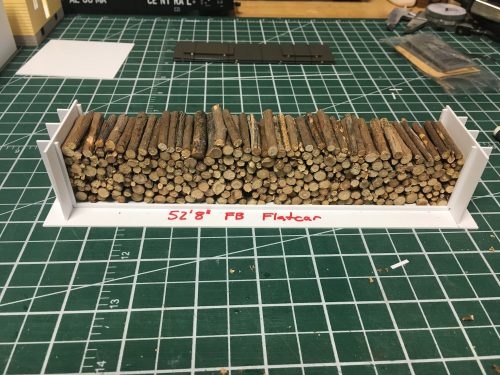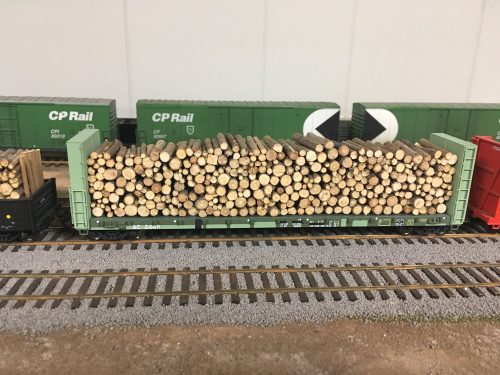As I may have mentioned a few times on this blog, pulpwood logs are a significant traffic item on the Algoma Central, and a type of load I’ll need quite a supply of for my flatcars and gondolas. I’ve been doing some playing around and simulating with some car cards and waybills and I figure on using anywhere from 15-20 pulpwood loads during a future operating session (when I have a layout to actually operate on some day), and these loads can be moved in at least five different types of cars (52′ flatcars, 40′ flatcars, 52′ gondolas, 61′ gondolas, 48′ gondolas), so I need a lot of loads and several different types of loads.
While there are some cast resin or plastic loads that you can get to fit certain models, they won’t fit some of the customized cars I have, and I’ve never really seen one made for a standard gondola. Moreover, just nothing looks as good as a load made of real logs.
Fortunately these aren’t too complicated to make, collecting real twigs of an appropriate size and cutting them to length. (If you – or a friend – has a bandsaw, cutting a lot of them very quickly is a breeze.) Really the trickiest part is selecting good twigs that are nice and straight so you can actually get a lot of logs out of them without “wasting” most of it.
Pulp logs in northern Ontario are typically cut to ~8′ lengths. This is a perfect size for loading crosswise in bulkhead flatcars and gondolas (with usually a 9′-9’6″ inside loading width) and purpose-built flatcars (or rebuilt/modified from plain bulkhead flatcars) for pulpwood service with side stakes have the stakes evenly spaced out for logs of this size. Once the “logs” are cut, they’re just stacked up on the cars. On the prototype, gravity and the friction of the rough surfaces of the logs is usually enough to keep everything in place (although trains carrying pulpwood loads “without side stakes and chains” are often subjected to speed restrictions and ACR timetables included special footnotes in the Special Instructions section to keep a close watch for shifted or protruding logs en route so it obviously isn’t 100% perfect and an obvious reason why the side-stake cars really took over in popularity.) On the model these physics don’t quite scale the same way, and we can make it much easier to load and unload the cars by gluing the logs together into a solid load.
To make it a bit easier to work on making some of these loads, I spent a little time in the workshop this week and tossed together some sheet styrene fixtures to the exact loading dimensions of some of my common car types for pulpwood service. This lets me assemble and glue together some loads on the workbench without banging actual cars around and risking damaging their details or getting glue on them. (And white glue peels right off the styrene when dry so a bit of liberal over-use is no bad thing when building in the fixture.)

Assembly fixtures for 52’8″ bulkhead flat, 52’6″ mill gondola, 40′ pulpwood flatcar. The flatcar load at top was previously a load for a kitbashed 51′ flatcar at the club which got dropped on the floor and turned into several pieces to be re-assembled. The missing area at the one end and a few gaps at the bottom still need to be filled in here

Finished load in Rapido 52’6″ gondola. Note vertical logs at ends to extend the height of the load. This was a common practice for loading pulpwood in gondolas.
Next steps: collect and cut a LOT more branches. I have three loads completed and I’m out of logs. I need at least 15-20 more to cover my eventual needs. Maybe more spread out across all the possible car types just so I have enough if the mix of loaded car types changes session to session (e.g more 52′ flatcars one session, more 61′ gondolas the next).



Those jigs are a great idea!
It’s surprising that the cars would be allowed to be piled so high above the sides of the gondolas. I think it’s the ends of the cars that really limit the height of the load. Photos I’ve seen of pulpwood cars – gondolas or bulkhead flats – always seem to have some kind of “stop” at the ends of the cars to prevent loads from shifting into the next car. The vertical logs perform the same function for gondolas without raised ends.
Yep I’ve seen plenty of prototype photos of gondolas loaded this way with 8′ logs. Several logs are placed vertically at the ends of the car and the weight of the load holds them in place against the car ends. This provides the extra “end bracing” to load more volume into the car.
Friction of the rough logs (mostly) keeps the logs from moving sideways. I have seen speed restrictions in RR timetables for trains hauling pulpwood in flats/open-top cars other than bulkhead flats with side stakes and chains.
I like the looks of your loads. Nice job
Thanks
Gary p.
I love those jigs. Nice idea which I’ll be using. Great looking loads by the way. One question.
Aren’t you concerned about shrinkage of your loads or have you dried them out already?
Thanks
Ryk
To be honest the logs in this load have been sitting in a container for several years…. so they’re pretty dried out by now.
I have a while to collect and cut branches and stockpile them for making new loads, and will probably do some large-scale drying in the future. Though I’ll need quite a lot of log loads for my future operations, my layout to use them on is still off in that future for now.
Excellent Idea to make the frames for building the loads. I have used saran wrap as a liner and then loaded cars, but sometimes hard to get out the first time, and so I have learned to add 2 pieces of .1000 styrene in each end of the car allowing the loads to slip in and out of any car. Now the I see what you have done, I hope that you don’t mind if I copy your ideas? What type of tree branches do you use, when I was young and working on the neighbours farm, we cut 4′ pulpwood and loaded 40 foot gondolas full of pine, spruce or balsam so I have been using those twigs to fill my cars. Do you happen to know if the Algoma Central ever owned Reefers or at least Temperature Controlled Boxcars?
Thanks for the ideas and any confirmation you can give me.
Of course not, that’s partly why I put this stuff up here!
Can use almost anything – you want small diameter twigs; something with a twig that’s nice a straight is good for cutting multiple “logs”. Although if you’re modeling 4′ logs instead of 8′ logs like they were using in northern Ontario you can get a lot out of anything. Almost any fallen branches or plants with woody stalks.
It doesn’t show on any equipment registers or listings, but I’ve seen photos of at least one (and likely just the one) wooden refrigerator car numbered AC 2801. This would probably have been in service around the 1940s. No evidence of anything more modern; so far this is the only evidence of any such cars on the ACR.
Great ideas. Do you know how the logs are stacked at the pulp mill? I am guessing in neat rows.
Yep, I’ve seen photos at various mills including the paper mill at Sault Ste. Marie served by the ACR and the logs are piled in relatively neat rows for storage.
Pulpwood loading yards usually have similar stacks of stored logs waiting for shipment, although logs can also be transferred directly from truck to railcar if there are empty railcars available on the loading spur.